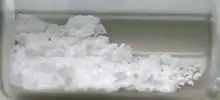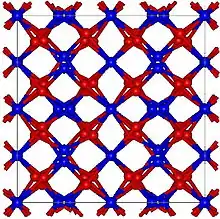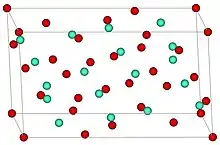Europium(III) oxide
Europium(III) oxide (Eu2O3), is a chemical compound of europium and oxygen. It is widely used as a red or blue phosphor in television sets and fluorescent lamps, and as an activator for yttrium-based phosphors. It is also an agent for the manufacture of fluorescent glass. Europium fluorescence is used in the anti-counterfeiting phosphors in Euro banknotes.[2]
 | |
| Identifiers | |
|---|---|
3D model (JSmol) |
|
| ChemSpider | |
| ECHA InfoCard | 100.013.787 |
PubChem CID |
|
| UNII | |
CompTox Dashboard (EPA) |
|
| |
| |
| Properties | |
| Eu2O3 | |
| Molar mass | 351.926 g/mol |
| Appearance | white to light-pink solid powder |
| Odor | odorless |
| Density | 7.42 g/cm3 |
| Melting point | 2,350 °C (4,260 °F; 2,620 K)[1] |
| Boiling point | 4,118 °C (7,444 °F; 4,391 K) |
| Negligible | |
| +10,100·10−6 cm3/mol | |
| Thermal conductivity | 2.45 W/(m K) |
| Structure | |
| cubic, cI80, Monoclinic | |
| Ia-3, No. 206, C2/m, No. 12 | |
| Hazards | |
| Lethal dose or concentration (LD, LC): | |
LD50 (median dose) |
5000 mg/kg (rat, oral) |
| Safety data sheet (SDS) | External MSDS |
| Related compounds | |
Other anions |
Europium(III) chloride |
Other cations |
Samarium(III) oxide, Gadolinium(III) oxide |
Except where otherwise noted, data are given for materials in their standard state (at 25 °C [77 °F], 100 kPa).
Infobox references | |
Europium oxide has two common structures: Monoclinic (mS30, space group C2/m, No. 12)[3] and cubic (cI80, space group Ia3, No. 206).[4] The cubic structure is similar to that of manganese(III) oxide.
It may be formed by ignition of europium metal.[5][6]
It can react with acids to form the corresponding europium(III) salts.
Gallery
 Cubic Eu2O3
Cubic Eu2O3 Monoclinic Eu2O3
Monoclinic Eu2O3
References
- Webelements Europium trioxide
- "Europium and the Euro". Archived from the original on 2009-08-04. Retrieved 2009-06-04.
- "ICSD Entry: 631453". Cambridge Structural Database: Access Structures. Cambridge Crystallographic Data Centre. Retrieved 2022-07-04.
- Heiba, Z. K.; Akin, Y.; Sigmund, W.; Hascicek, Y. S. (2003). "X-ray structure and microstructure determination of the mixed sesquioxides (Eu1−xYbx)2O3 prepared by a sol–gel process". J. Appl. Crystallogr. 36 (6): 1411–1416. doi:10.1107/S0021889803019319.
- Ugale, Akhilesh; Kalyani, Thejo N.; Dhoble, Sanjay J. (2018). "Chapter 2 - Potential of europium and samarium β-diketonates as red light emitters in organic light-emitting diodes". In Martín-Ramos, Pablo; Ramos Silva, Manuela (eds.). Lanthanide-Based Multifunctional Materials: From OLEDs to SIMs. Elsevier. pp. 59–97. doi:10.1016/B978-0-12-813840-3.00002-8. ISBN 978-0-12-813840-3.
- "Europium". ScienceDirect. Elsevier. Retrieved 2022-07-04.
Europium is the most reactive rare-earth element... It swiftly oxidizes in air, ignites in the range of 150–180°C to form Eu3+ oxide (Eu2O3).
This article is issued from Wikipedia. The text is licensed under Creative Commons - Attribution - Sharealike. Additional terms may apply for the media files.